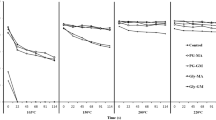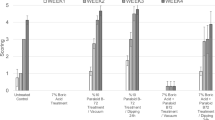Abstract
Environmental pressures in France and in most European countries during the last decade have led to the development of more environmentally acceptable preservation methods. In this context, wood heat treatment is one of the most investigated alternative methods. Important chemical modifications resulting from thermo-degradation reactions confer new properties to wood, like increased decay resistance or higher dimensional stability, while mechanical properties like tensile strength decrease after treatment. However, the improved durability of heat treated wood is not sufficient to allow its utilization in ground contact, where it is subjected to insect and fungi attacks. Impregnation with borax before thermal treatment could be an interesting method to improve the properties of thermally modified wood. Boron is a relatively harmless biocide that improves resistance to fungi and insects like termites. Additionally, borax can also improve wood fire resistance due to its fire retardant effect. To reduce boron leachability, two additives previously developed in the laboratory corresponding to water soluble polymerizable polyglycerol derivatives were added to the borax solution, taking advantage of thermal treatment to fix the latter through polymerization within the wood structure limiting boron leachability.


Similar content being viewed by others
References
AWPA standard A7-93 (1993) American Wood Preservers’ Association Standard. Standard for wet ashing procedures for preparing wood for chemical analysis
Barnes HM, Amburgey TL, Williams LH, Morell JJ (1989) Borates as wood preserving compounds: the status of research in the United States, IRG/WP 3542. International Research Group on Wood Preservation, Stockholm
Baysal E, Ozaki SK, Yalinkilic MK (2004) Dimensional stabilization of wood treated with furfuryl alcohol catalysed by borates. Wood Sci Technol 38:405–415
Candelier K, Chaouch M, Dumarçay S, Pétrissans A, Pétrissans M, Gérardin P (2011) Utilization of thermodesorption coupled to GC-MS to study stability of different wood species to thermodegradation. J Anal Appl Pyrol 92(2):376–383
Candelier K, Dumarçay S, Pétrissans A, Gérardin P, Pétrissans M (2013a) Comparison of mechanical properties of heat treated beech wood cured under nitrogen or vacuum. Polym Degrad Stab 98(9):1762–1765
Candelier K, Dumarçay S, Pétrissans A, Pétrissans M, Kamdem P, Gérardin P (2013b) Thermodesorption coupled to GC-MS to characterize volatiles formation kinetic during wood thermodegradation. J Anal Appl Pyrol 101:96–102
Chaouch M, Pétrissans M, Pétrissans A, Gérardin P (2010) Utilization of wood elemental composition to predict heat treatment intensity and decay resistance of different softwood and hardwood species. Polym Degrad Stab 95:2255–2259
Chaouch M, Dumarçay S, Pétrissans A, Pétrissans M, Gérardin P (2013) Effect of heat treatment intensity on some conferred properties of different European softwood and hardwood species. Wood Sci Technol 47(4):663–673
Drysdale AJ (1994) Boron treatments for the preservation of wood—a review of efficacy data for fungi and termites, IRG/WP 94-30037. International Research Group on Wood Preservation, Stockholm
EN 335-2 (2007) European Norm. Durability of wood and wood-based products-definition of use classes—Part 2: application to solid wood
ENV 1250-2 (1994) Wood preservatives—Methods for measuring losses of active ingredients and other preservative ingredients from treated timber—Part 2: Laboratory method for obtaining samples for analysis to measure losses by leaching into water or synthetic sea water, European Committee for Standardization
Esteves BM, Pereira HM (2009) Wood modification by heat treatment—a review. Bioresources 4(1):370–404
Freitag C, Morrell JJ (2005) Development of threshold values for boron and fluoride in non soil contact applications. Forest Prod J 55:97–101
Gezer ED, Michael JH, Morrell JJ (1999) Effects of glycol on leachability and efficacy of boron wood preservatives. Wood Fiber Sci 31:136–142
Kartal SN (2006) Combined effect of boron compounds and heat treatments on wood properties: boron release and decay and termite resistance. Holzforschung 60(4):455–458
Kartal SN, Green F (2003) Leachability of boron from wood treated with natural and semi-synthetic polymers and calcium precipitating agent. Holz Roh Werkst 61:388–389
Kartal SN, Imamura Y (2004) Effects of N’-N-(1, 8-naphthalyl) hydroxylamine (NHA-Na) and hydroxyl naphthalimide (NHA-H) on boron leachability and biological degradation of wood. Holz Roh Werkst 62:378–385
Kartal SN, Yoshimura T, Imamura Y (2004) Decay and termite resistance of boron-treated and chemically modified wood by in situ co-polymerisation of allyl glycidyl ether (AGE) with methyl methacrylate (MMA). Int Biodegr 53:111–117
Kartal SN, Hwang WJ, Imamura Y (2008) Combined effect of boron compounds and heat treatments on wood properties: chemical and strength properties of wood. J Mat Process Tech 198:234–240
Kikuchi S, Maeda S (2007) Effects of fire retardant chemicals and retention on heat release rate of wood. Mokuzai Gakkaishi 53(5):276–282
Korkut S, Mehmet A, Turker D (2008) The effects of heat treatment on some technological properties of Scots pine (Pinus sylvestris L.) wood. Bioresour Technol 99:1861–1868
Lloyd JD (1998) Borates and their biological applications, IRG/WP 98-30178. International Research Group on Wood Preservation, Stockholm
Mburu F, Dumarçay S, Huber F, Pétrissans M, Gérardin P (2007) Evaluation of thermally modified Grevillea robusta heartwood as an alternative to shortage of wood resource in Kenya: characterisation of physicochemical properties and improvement of bio-resistance. Bioresour Technol 98:3478–3486
Mburu F, Dumarçay S, Bocquet JF, Pétrissans M, Gérardin P (2008) Effect of chemical modifications caused by heat treatment on mechanical properties of Grevillea robusta wood. Polym Degrad Stab 93:401–405
Militz H (2002) Thermal treatment of wood: European processes and their background, IRG/WP 02-40241. The International Research Group on Wood Preservation, Stockholm
Mohareb A, Thévenon MF, Wozniak E, Gérardin P (2010) Effects of monoglycerides on leachability and efficacy of boron wood preservatives against decay and termites. Int Biodeter Biodegr 64:135–138
Mohareb A, Thévenon MF, Wozniak E, Gérardin P (2011) Effects of polyvinyl alcohol on leachability and efficacy of boron wood preservatives against fungal decay and termites attack. Wood Sci Technol 45(2):369–382
Mourant D, Yang DQ, Lu X, Riedl B, Roy C (2009) Copper and boron fixation in wood by pyrolytic resins. Bioresour Technol 100:1442–1449
Obanda DN, Shupe FT, Barnes HM (2008) Reducing leaching of boron based wood preservatives—a review of research. Bioresour Technol 99:7312–7322
Obounou Akong F, Pasc A, Mutlu M, Cosgun S, Gérardin P, Gérardin-Charbonnier C (2013) Hydrogels obtained from an original catanionic system for efficient formulation of boron wood-preservatives. Int Biodeter Biodegr 77:123–126
Patzelt M, Stingl R, Teischinger A (2002) Termische Modifikation von Holz und deren Einfluss auf ausgewählte Holzeigenschaften in Modifiziertes Holz Eigenschaften und Märkte. Lignovisionen Band 3. ISSN 1681–2808:101–149
Preston AF, Mc Kaig PA, Walchesi PJ (1985) Termite resistance of treated wood in an above ground field test, IRG/WP 2241. International Research Group on Wood Preservation, Stockholm
Raberg U, Daniel G, Terziev N (2012) Loss of strength in biologically degraded thermally modified wood. Bioressources 7(4):4658–4671
Roussel C, Marchetti V, Lemor A, Wozniak E, Loubinoux B, Gérardin P (2001) Chemical modification of wood by polyglycerol/maleic anhydride treatment. Holzforschung 55:57–62
Schoeman WM, Lloyd JD (1998) International standardization: a hypothetical case study with stand-alone borate wood preservatives, IRG/WP 98-20147. International Research Group on Wood Preservation, Stockholm
Soulounganga P, Marion C, Huber F, Gérardin P (2003) Synthesis of polyglycerol methacrylate and its application to wood dimensional stabilization. J Appl Polym Sci 88:743–749
Soulounganga P, Loubinoux B, Wozniak E, Lemor A, Gérardin P (2004) Improvement of wood properties by impregnation with polyglycerol methacrylate. Holz Roh Werkst 62:281–285
Surini T, Charrier F, Malvestio J, Charrier B, Moubarik A, Castéra P, Grelier S (2012) Physical properties and termite durability of maritime pine Pinus pinaster Ait heat-treated under vacuum pressure. Wood Sci Technol 46:487–501
Temiz A, Alfredsen G, Eikenes M, Terziev N (2008) Decay resistance of wood treated with boric acid and tall oil derivates. Bioresour Technol 99:2102–2106
Thévenon MF, Pizzi A (2003) Polyborate ions influence on the durability of wood treated with non-toxic protein borate preservatives. Holz Roh Werkst 61:457–464
Thévenon MF, Pizzi A, Haluk JP (1997) Non-toxic albumin and soja protein borates as ground-contact wood preservatives. Holz Roh Werkst 55:293–296
Thévenon MF, Pizzi A, Haluk JP (1998) Protein borates as non-toxic, long-term, wide-spectrum, ground- contact wood preservatives. Holzforschung 52:241–248
Tomak ED, Hughes M, Yildiz UC, Viitanen H (2011) The combined effects of boron and oil heat treatment on beech and Scots pine wood properties. Part 1: boron leaching, thermogravimetric analysis and chemical composition. J Mater Sci 46(3):598–607
Toussaint-Dauvergne E, Soulounganga P, Gérardin P, Loubinoux B (2000) Glycerol/glyoxal: a new boron fixation system for wood preservation and dimensional stabilization. Holzforschung 54:123–126
Vernois M (2001) Heat treatment of wood in France—state of art. Proceedings of special seminar review on heat treatment of wood, Antibes, France 9 February. BFH the federal research centre for forestry and forest products, Hamburg, pp 39–46
Yildiz S, Gezerb D, Yildiz C (2006) Mechanical and chemical behavior of spruce wood modified by heat. Build Environ 41:1762–1766
Acknowledgments
The authors gratefully acknowledge the financial support of the CPER 2007–2013 “Structuration du Pôle de Compétitivité Fibres Grand’Est” (Competitiveness Fibers Cluster). LERMAB is supported by a grant overseen by the French National Research Agency (ANR) as part of the “Investissements d’Avenir” program (ANR-11-LABX-0002-01, Lab of Excellence ARBRE).
Author information
Authors and Affiliations
Corresponding author
Rights and permissions
About this article
Cite this article
Salman, S., Pétrissans, A., Thévenon, M.F. et al. Development of new wood treatments combining boron impregnation and thermo modification: effect of additives on boron leachability. Eur. J. Wood Prod. 72, 355–365 (2014). https://doi.org/10.1007/s00107-014-0787-7
Received:
Published:
Issue Date:
DOI: https://doi.org/10.1007/s00107-014-0787-7




